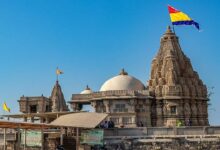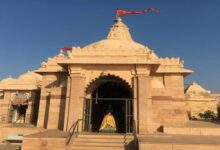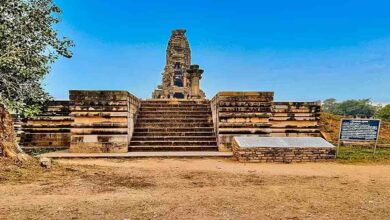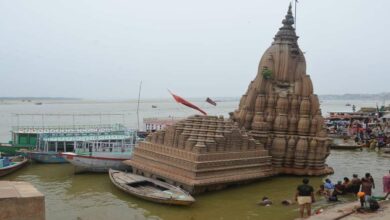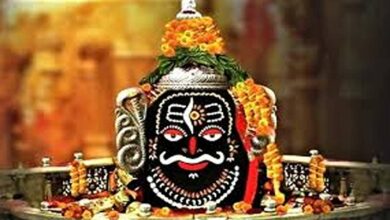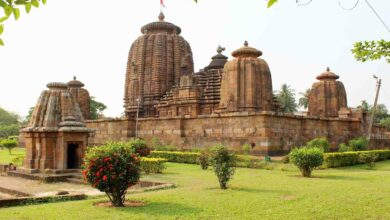Karni Mata Temple: 20 thousand rats are worshipped in this temple, know the history behind it
Karni Mata Temple: In India, Hinduism is a long-standing and diversified religion. Among its essential components are symbolism and spirituality. Furthermore, these two facets of Hinduism are deeply rooted in animals. Indeed, one of the most prominent features of Indian society is the strong Hindu belief in animal cruelty. These animals have been seen as a sign of culture, a source of love and harmony, and an inspiration for growth in several ancient Indian literary works. Animals and humans are said to have similar lives, with the exception that humans’ senses are not completely developed like those of animals.
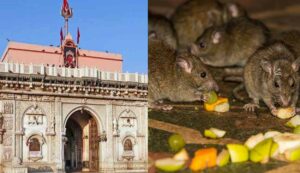
The significance of animals in nature has also been highlighted, from the categorization of species to the many animal manifestations of the gods. In India, the more strongly animals are mentioned, the more intrigued one becomes. However, the only way to get a sense of the threshold of this centuries-old culture is to visit the nation’s many holy sites and learn about their history. The well-known Karni Mata Mandir of Bikaner is a prominent religious site in India.
This temple, also called Karni Mata Mandir, is the most popular tourist destination in Bikaner. The villagers believe that Karni Mata, the temple’s patroness, is an embodiment of Hinduism’s protective goddess, Durga. The fourteenth-century Hindu warrior sage Karni Mata belonged to the Charan caste. Karni Mata, who led an austere life, was much respected by the community and had a large following. She also laid the foundation stone for the Mehrangarh and Bikaner forts at the behest of the Maharajas of Jodhpur and Bikaner. While there are other temples devoted to her, the most well-known is this one located 30 kilometers from Bikaner in the village of Deshnok. We’ll tell you about the temple that honors her in this blog.
About Deshnok’s Karni Mata Temple
Karni Mata Temple, often known as the Rat Temple, draws pilgrims and visitors from all over the world. Goddess Karni Mata, who is said to be an incarnation of Goddess Durga, is the object of devotion at this highly esteemed shrine. There are more than twenty-five thousand Kaba rats in the temple. Since they are said to be the offspring of Karni Mata, passing the white Kaba between your legs is very lucky.
Approximately 600 Charan dynasty households believe they will reincarnate as rats and claim to be descended from Karni Mata. The kul devi of the Bikaner royal dynasty is also Karni Mata. She was a 14th-century woman who performed several miracles. One of the well-known stories connected to the temple is that Karni Mata prayed to Yamraj, the deity of death, so much that he not only spared Laxman from drowning but also brought him back when he drowned in Kapil Sarovar while trying to sip water. All of Lakshmana’s sons were reincarnated as rats, but he himself was revived.
It’s interesting to note that these rats have never been linked to the transmission of any illness and do not emit any odors as other rats do. In fact, eating food that rats have nibbled on is lucky. The temple has solid silver doors and a stunning marble facade. Early in the 20th century, Maharaja Ganga Singh of Bikaner finished the structure as it is now. Before you leave the temple grounds, remember to place a wish in the lion’s ear at the main gate. On the route back to Bikaner from Deshnok, tourists may also stop at the freshly constructed Karni Mata Panorama. The museum uses exquisite sculptures, paintings, and tableaus to tell the story of Karni Mata.
Karni Mata Bikaner’s legend
The Karni Mata temple has intriguing mythology in addition to its distinctive rituals. The tale of Karni Mata’s stepson Laxman is the most well-known of these stories. Laxman perished in water one day while trying to sip it from Kapil Sarovar in Kolayat tehsil. Karni Mata, who is grieving over his passing, prays to Yama, the Hindu deity of death, but he first denies her wish to revive her son. He gives in to her request, nevertheless, and reincarnates not only Laxman but all of Karni Mata’s sons as rats after being affected by her anguish and longing.
The settlement of Deshnok in Rajasthan’s Bikaner region, which is well-known for its distinctive devotion and belief, is linked to the Karni Mata narrative. Because hundreds of rats reside in her temple and are fervently adored there, Karni Mata is also known as the Goddess of Rats and is revered as a Shakti Swaroop Devi.
Karni Mata was born in the fourteenth century, according to the legend. She was a member of the Charan community and went by Ridhubai in real life. Karni Mata demonstrated her superhuman abilities as a young girl and devoted her life to promoting social justice. She was the society’s patron in addition to being a saint. With the assistance of several rulers, she brought stability to the royal families of Jodhpur and Bikaner.
A folktale states that Laxman, Karni Mata’s stepson, once perished after falling into a pond of water. Karni Mata begged the deity of death, Yamraj, to grant her son life. Karni Mata utilized her abilities to transform Laxman into a rat and then gave him life again when Yamraj rejected. This led to the notion that Karni Mata’s followers are resurrected as rats and serve the mother when they die. Because of this, the temple of Deshnok is home to hundreds of rats, which the visitors treat with the utmost dignity and care.
Kaba are the rats that reside at this temple. Here, caring for and feeding the rats is seen as religious. Since white rats are said to be a manifestation of Karni Mata, seeing one is seen to be very fortunate.
Devotees still go from far and wide to see the mother at the Karni Mata Temple in Deshnok, which is a remarkable location. The legend of Karni Mata and her magnificent temple has become a significant part of Rajasthan’s cultural legacy.
What distinguishes the temple?
The Karni Mata Temple in Bikaner is well-known for the more than 25,000 rats that reside on the grounds and walk freely, not for its setting or architectural design. Visitors’ and devotees’ feet are often crossed by these critters as they emerge from crevices in the walls and flooring. Here, eating food that these rats have nibbled on is truly seen as a sacred ritual.
Visitors from all around India and outside come to see this breathtaking spectacle, and they also bring milk, candies, and other gifts for these sacred animals. Since white rats are said to be the manifestation of Karni Mata and her sons, they are particularly revered among all rats. The presentation of sweets is one of the many ways that visitors try to entice them away. But it is a serious sin to accidentally injure or kill a mouse in this shrine. As a kind of atonement, those who commit this act must swap out the dead rat for a gilded one.
The Mystery of Karni Mata Temple
According to legend, Karni Mata encountered Yama, the God of Death, after one of her sons, Lakshmana, passed away and requested that her son’s life be returned. After first rejecting her, Lord Yama finally gave in. He turned her kid into a rat, as well as the other male Charan clan members. According to him, every member of her family will be born as a rat and then die again and become a human. As a result, this Karni Mata Deshnok Temple has a lot of rats.
Architecture of the Karni Mata Temple
Maharaja Ganga Singh of Bikaner constructed the Karni Mata Temple in the beginning of the 20th century. The temple’s architecture is reminiscent of the Mughal style and is entirely composed of marble. The sturdy silver doors that lead to the complex’s entrance further enhance the allure of the lovely marble façade. A number of the goddess’s stories are shown on the silver door panels. In the inner sanctuary of the temple stands the 75 cm-tall idol of Karni Mata of Bikaner, who is wearing a crown and garland and is clutching a trident in one hand. On each side of the goddess’s idol are the idols of her sisters. In 1999, Kundan Lal Verma, a Karni Jeweller from Hyderabad, enlarged the temple. His contribution was the temple’s silver doors and marble sculptures.
Important Karni Mata Temple Rituals and Events
The Charan Pujaris execute Mangala-ki-Aarti and Bhog Prasad as part of the regular schedule at Karni Mata Temple. Additionally, devotees who come to the temple present the goddess and the Kabbas (rats) with a variety of offerings. These contributions are often divided into two categories: Kalash-Bhent, which is used for temple upkeep, and Dwar-Bhent, which is given to the priests and temple employees.
In addition, Bikaner’s Karni Mata Temple is well-known for its twice-yearly Karni Mata Fair. These fairs are scheduled to take place during the two Navratris.
1. From Chaitra Shukla Ekam to Chaitra Shukla Dashami between March and April
2. From Ashvin Shukla to Ashvin Shukla Dashami between September and October
During these fairs, thousands of people attend. The hours of Karni Mata Temple are 4 a.m. to 10 p.m. Every night, there is no admission charge to the temple.
How to go to the Temple of Karni Mata
Deshnok Temple is easily accessible in the morning or afternoon and is about an hour’s drive from Bikaner. Hiring a cab or jeep is the best option. The temple is free to enter. The cost of the camera might sometimes be incurred. Remember to include an extra pair of socks. Having a plastic bag on hand is also helpful for storing your used socks. Slippers may also be borrowed on the spot. You may purchase food for the rats and drink for yourself at a number of kiosks near the entrance.
Beliefs of Karni Mata Temple
It is still believed that the Charan Vansh, the tribe of Karni Mataji, took the form of the Kabbas, the rats of Karni Mata Temple. Their eating and rearing are taken care of, and they are very fortunate. They are linked to several beliefs and rites, which play a significant role in the Karni Mata Temple’s history. It is seen as a lucky break if one of these rats passes over you. Think of yourself as fortunate!
There are several white rats among the usual brown and black rats. It is said that these white people are Karni Mata and her sons. You’ll be extra fortunate if you see any of these white rats from Karni Mata Temple. You must provide pure gold as atonement if you kill or inadvertently stamp on a rat. Additionally, it has to be the same size as the deceased rat. Devotees actually take the food back and consume it since it is thought that everything that is donated to these rodents and their leftovers is extremely fortunate.
Facts about the Karni Mata Temple
- Rajasthan is home to several other Karni Mata shrines. In actuality, Karni Mata Temples in Alwar and Udaipur are really well-liked. But of all the rat temples, this one in Deshnok is the only one.
- According to legend, Karni Mata laid the groundwork for the well-known Mehrangarh Fort in Jodhpur and the Junagarh Fort in Bikaner.
- There are a lot of rats outside the Deshnok Karni Mata Temple, even if there are a lot of rats within. All of them reside inside the temple.
- Remarkably, no cases of plague have been documented at or around Deshnok Temple Bikaner, despite the fact that there are a lot of rats there.
- The windows and doors of this Karni Mata Temple in Deshnok are made of real silver.
The Karni Mata idol is holding a trident. According to popular belief, Goddess Durga resided and worked marvels in the 14th century at the location of the temple today. The erstwhile royal family is said to have been protected by the god. Two of Rajputana’s most significant forts are said to have had their foundation stones placed by Karni Mata. During her lifetime, the majority of the temples devoted to Karni Mata were constructed. Because of the rat population, the Karni Mata Temple in Deshnok is the most well-known of all the temples.
In summary, the Karnataka Mata Temple
We really hope you enjoyed our post on Karni Mata Temple Bikaner. Please use the comment box to ask any questions you may have, and we will do our best to respond as quickly as we can. Please visit our website, Jan Bhakti, regularly to read more exciting articles like this one in the future. Thank you!
FAQs
Q. How can one go to Karni Mata Temple the most effectively?
A. The Karnataka Mata Rat Temple is situated in the Rajasthani hamlet of Deshnok. Bikaner, which is 30 kilometers away, is the closest city to this town. Bikaner has its own train station and airport. There are several public buses that will transport you to Deshnok after you arrive in the city. As an alternative, you may go to Deshnok by cab from Bikaner.
From Bikaner to Deshnok, you may also take a local train. After only thirty minutes of rail travel, you may stroll to the Rats Temple in Deshnok. Because of the train’s excellent regularity, you may schedule your return trip to Bikaner for a few hours from now.
Q. What is the ideal lodging option close to Deshnok Karni Mata Temple?
A. Since Deshnok is a tiny community with few lodging alternatives, I would advise staying in Bikaner. In contrast, Bikaner has hotels at every price range. Budget historical havelis like Bhavar Niwas or opulent heritage hotels like Laxmi Niwas Palace are your options.
Q. What are Karni Mata Temple’s hours?
A. Karni Mata Temple is open day from 4 a.m. to 10 p.m. At four in the morning, Karni Mata Temple performs its first aarti.
Q. Does Karni Mata Temple charge admission?
A. No, there isn’t a charge to enter the temple. However, you would be required to pay a photographic charge as a visitor, which is Rs 70 for video cameras and Rs 30 for cameras.
Q. What additional locations close to Karni Mata Temple are worth seeing?
A. The sole place to visit in Deshnok is the Karni Mata Temple. Rampuria Haveli, Junagarh Palace, the Royal Monuments of Bikaner, Laxmi Niwas Palace, and other sites are among the many places to visit in Bikaner.
Q. What is the number of rats at Karni Mata Temple?
A. The Karni Mata Temple is home to over 25,000 rats.
